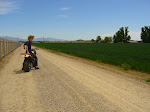Dec 2005 Summer 2008
1920 x 1080 Resolution 1920 x 1080 Resolution
480i/p, 720i/p, 1080i 480i/p, 720i/p, 1080i/p
ASA 320 ASA 500
82mm Leica Lens 72mm Leica Lens
4.2-55 zoom 3.9-51 zoom
*widest of any prosumer out now
Tape Deck & P2 P2 Only
Sharp LCD Sharper LCD
*Easier to Focus
N/A Waveform Monitor
N/A 3 Second Pre-Roll
N/A DRS Control
Little Image Trails Less Image Trails
Noise at +3-6db Noise at +6-9db
5.5 lbs 4.1lbs
In Conclusion
The HPX170 is noticeably lighter with more solid connections in and out of the camera, a big problem with the HVX200. The new features such as the WFM, advanced focus assist, and DRS controls are a huge plus but only in function not performance
The real difference is the wider lens but at the cost of having less telephoto. The improved DSP gives the HPX a half stop brighter chip, less noise in the blacks, and a smoother (less trails) image. However, these are almost unnoticeable unless scrutinizing the images side by side. The addition pf 1080p puts the HVX up with any other prosumer camera on the market and was a pitfall of the HVX200. The DVCPRO codec delivers 4:2:2 color sampling at a 100mb/s data rate as opposed to SONY’s HDV codec at 4:2:2 but only 25mb/s. That gives Panasonic the advantage with less compression of the image but more data to handle. Despite the 1080p addition, 720pn is still the most versatile shooting standard and looks almost identical to 1080p footage when uprezed.
HVX

HPX

You can see the more realistic color rendition and less green in the overall image. Also, there is a lot more detail in the darks with the 1/2 stop brighter HPX. If you look closely you can see a bit more detail in the HPX still, but it’s almost imperceptible on a moving image.
HVX

HPX

Most noticeably is the green in the HVX still, and the HPX image looks slightly more washed out and less contrasty. This is easily fixed in your NLE by adding a bit more saturation and crushing the blacks, and unlike the HVX image, which would need to have green removed and thus adding red, the HPX image will have more accurate color after color correction. I, and most colorists, prefer a clean colored image with more data to work with in the darks. The HPX, although seeming inferior in the still, delivers more control in post.
Mega Thanks to: Dan Brockett for the stills


No comments:
Post a Comment